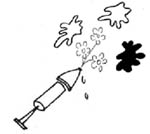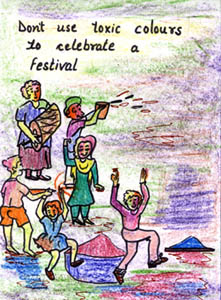|
CLEAN-India Celebrates
Eco-friendly Holi Col. V. Katju
Such a colourful Holi was soon overtaken by commercialisation which started providing exotic colours but in a highly dangerous form. Toxic chemicals are being used to get the desired colours :
All these are highly dangerous to the skin, eyes, respiratory tract, can cause renal disorder and some are even carcinogenic. They do not wash away easily, get mixed in drains and sewage systems and pollute water bodies and the soil. The festival, which used to be a healthy revelry of both men and women, boys and girls, is no longer an exuberant, healthy event. Womenfolk shy away in fear of being splashed and smeared with toxic colours, enamel paint, and even cow dung. Action Plan To make people aware about these eco-friendly natural colours, CLEAN-India has spearheaded a campaign against toxic Holi colours. Our message for Eco Holi is "Holi Ke Rang, Phoolon Ke Sang". Workshops have been carried out in numerous schools of Delhi, Noida and Gurgaon and 17 other CLEAN-India centres. CLEAN has spread awareness and imparted training to make simple eco-friendly Holi colours among thousands of school children and teachers. Here the students were apprised of the harmful effects of the Holi colours sold in the market and were taught how to make natural and safe colours at home. The excited students promised to spread this message to their friends and family. Many people have returned to natural colours for Holi. Some of the comments from our students:
In Delhi, CLEAN-Delhi has been fortunate enough to get full support from the Delhi government in spreading awareness on a mass scale. In close co-ordination with Delhi Government and the active encouragement of the Chief Minister Smt. Sheila Dikshit, CLEAN-Delhi took upon itself to propagate eco-friendly Holi colours for the festival on 29 March 2002. The slogan was: "Khelo Holi Naturally" and "Holi Ke Rang Phoolon Ke Sang". The Delhi Government was gracious enough to provide a stall at Delhi Haat, near the INA Market. The Environment Systems Branch of Development Alternatives geared itself for the task. The main objectives were :
CLEAN-Delhi children were asked to create
awareness among the communities. They took a pledge not to use
synthetic colours in their homes and (alongwith their parents)
impressed upon the various Residents Welfare Associations in their
zones on reviving the traditional ways of playing Holi. The tribal
self-help groups of women in Newari Block of Tikamgarh District, M.P.
went on an overdrive. Under the watchful eyes of D.A. professionals
at TARAgram, the regional centre near Orchha, the plan took shape.
Four
Production at TARAgram The Hand-made Paper Unit at TARAgram was asked to manufacture gift packs along with kalawa, the sacred orange-yellow thread for wrapping the pack. Care was taken to ensure that no polythene was used for packaging. The gift packs were made by 40 Sahariya Tribal Women who work in the Handmade Paper Unit at TARAgram. Customised packaging was done for Dr. Morepen Group of pharmaceutical industry on receipt of firm orders. Turmeric, which is widely grown in the Bundelkhand region was procured. Self-help groups were given instructions to ensure quality production in terms of consistency, correct mix of ingredients and soothing colour. Tesu flowers were collected and dried and put in packages having instructions on preparation of water colours like boiling the dried flowers in correct quantity of water, keeping it overnight and diluting it with water for a soothing yellow-orange fragrant colour. Strategy As it was the first year when these colours were being introduced, the strategy was to produce a limited number of packages. Shops in various markets of Delhi were contacted for their co-operation as any change would be resisted by wholesalers and retailers who do brisk business with synthetic colours during this one-day festival.
The shopkeepers were initially hesitant to take large quantities even after an assurance that unsold colours will be taken back. They were also coaxed to retain minimum profit margins, keeping in view society’s commitment to lend a helping hand to the low income group and poorer sections of the community. The Armed Forces also showed keen interest, especially the Engineer-in-Chief’s Branch at Army Headquarters and Rajputana Rifles Regimental Centre. The latter took a bold step to completely ban toxic colours in the Regimental Centre and gave strict orders to the civil contractor not to keep them in the canteen. Distribution & Sale As the auspicious day neared, the sales picked up. Two women members of the self-help group from Newari were invited to Delhi and managed the stall at Delhi Haat, explaining to the shoppers the ingredients and methods of preparation. Very soon, awareness was created. CLEAN-Delhi schools were most generous and co-operative in not only purchasing sizeable quantities for themselves but also taking packets for their local communities, explaining to the people the benefits of eco-friendly colours. Ms. Naini Jayaseelan, Secretary Environment in the Delhi Government, not only gave a helping hand but also did a bit of marketing herself. For the Delhi markets, it was a novelty, something they had never seen before and a replacement of the hideous toxic colours for which they never realised there would be an alternative. Children who had gone out with their parents for Holi shopping were so receptive of the novelty that they prevailed upon their parents to spend a bit extra for the natural colours. Such a care for the environment by those at this tender and formative age was most heartening to see. Although the introduction of these eco-friendly colours was miniscule keeping in view the large population, it has been a grand leap forward in creating awareness about eco-friendly products. Conclusion CLEAN-India Programme has taken propagation of eco-friendly colours during Holi rather seriously. It is a part of their social commitment of campaigns against environmental degradation practices. Once the awareness is created, the citizens will join in wholeheartedly to create a movement, which will act as a soothing balm on the wounds that we human beings have inflicted on Mother Nature. A tiny spark will certainly ignite a fire of consciousness, a realisation of being in tune with nature. We have to think what we can give to improve the environment and not what we keep on taking endlessly from it, far beyond our needs. We are confident that a radical attitudinal change will result during the Holi of 2003, reminding us of our culture, our traditions and the Divine flute-playing Avatar (Lord Krishna) in his Ras Leela, a communion between Purush and Prakriti, in tune and in step, during this wonderful festival of colours, joy, fun frolic. q
|


